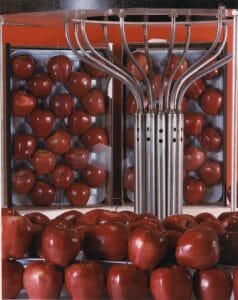Irradiation Definition
Irradiation refers to the exposure of a substance to radiation from a variety different sources. Radiation can be ionizing or non-ionizing, referring to either purposeful versus natural sources of radiation, respectively. Some examples of ionizing radiation include electronics, visible and infrared light, microwaves, and electromagnetic waves (e.g., radio waves, power, and electronic receivers). Irradiation is used for several purposes, with food sterilization (using X-rays or gamma rays) and medical imaging (using a radioactive dye for diagnostic imaging) being some of the most popular applications of ionizing radiation. Food irradiation does not involve contact with the product exposed to radiation, and does not result in radioactive products.
Examples of Food Irradiation
Ionizing radiation is commonly used to irradiate food products in order to sterilize foods for the protection of consumers against various pathogens found in meat and vegetables, or to delay the germination of various plants. Food irradiation is often termed “cold pasteurization” because it does not heat foods like traditional pasteurization. During the irradiation process, entire food pallets will be subjected to the predetermined dose. The dose is monitored by a densitometer, which ensures that the food products are exposed to the correct dose as determined by defined regulations. Each country has regulations concerning the dose of irradiation that can be applied to foods. The specific radiation dose is categorized as either high, medium, or low doses. Some examples are as follows:
- High: Dosage higher than 10 kGy. Meat products (e.g., poultry) is commonly sterilized with a high dose of radiation.
- Medium: Dosage between 1 and 10 kGy. The purpose is generally to eliminate micro-organisms from food products to prevent spoilage and the spread of pests.
- Low: Dosage lower than 1 kGy. Low doses are typically used to delay germination and ripening of plants.
Irradiation for Agricultural Applications
Irradiation techniques are widely applied in agriculture to introduce genetic variation in plants, as well as delay plant germination and sprouting. Moreover, irradiation is also applied to crops as a form of insect control. In agriculture, X-rays, gamma rays, UV light, and heavy-ion beams are the most common forms of irradiation used. The irradiation of food products is highly regulated, with the dose tightly controlled. Any chemicals generated via the irradiation process have been deemed non-toxic and comparable to those present following other sterilization methods. In agriculture, the prevention of spoilage is largely achieved through pest control (e.g., insects, viruses, and bacteria) by eliminating pathogens using a safe dose of radiation. In addition to pest control, irradiation also decreases the function of enzymes that promote spoilage and ripening following the harvest of crops. Since the spoilage of food products is reduced by irradiation, both transport time and shelf life can be extended.
Gamma Radiation
The most common form of food irradiation is gamma radiation. Gamma rays are emitted from the decay of radioactive material. For safety purposes, the radioactive material is placed into a storage container surrounded by water or shielded to prevent food products and workers from exposure to the radioactive material. The most common source of gamma radiation for food products is cobalt-60 (see below). Gamma radiation is the most preferred type of food irradiation because the rays fully penetrate the food pallet and it is relatively inexpensive compared to some of the other forms of radiation (e.g., X-rays and electron radiation).
X-ray Radiation
Food irradiation with the use of X-rays involves the collision of X-rays with food products. The advantage of X-ray irradiation is that the use of radioactive materials is not required and it provides greater dose uniformity compared to gamma radiation. Moreover, since X-rays are generated electronically, the devices can be turned off when not in use, which decreases the associated safety concerns for the workers. However, X-ray radiation is not used to the same extent for food irradiation purposes as gamma rays because it is more expensive.
Electron Radiation
Another form of food irradiation is electron radiation, which involves the use of electron streams traveling close to the speed of light induced by radio waves or other electronic sources. However, while this method is safer compared to the use of X-rays and gamma radiation, electrons do not penetrate the food products as deeply and cannot be applied to an entire food pallet, which can be achieved with gamma radiation.
Quiz
1. A concern associated with electron irradiation of food products would be:
A. Exposure to radioactive material
B. Adequate penetration of the food products
C. The generation of toxic chemicals
D. Exposure to X-ray radiation
2. Which of the following is NOT a primary purpose of food irradiation:
A. Sterilization
B. Delay food ripening
C. Enhance food taste
D. Delay plant spouting
References
- Brinston RM and Wilson BK. (1993). Converting to gamma-radiation sterilization: an overview for medical device manufacturers. Med Device Technol. 4(4):18-22.
- Farkas J. (1998). Irradiation as a method for decontaminating food. A review. Int J Food Microbiol. 44(3):189-204.
- Pillai SD and Shayanfar S. (2017). Electron Beam Technology and Other Irradiation Technology Applications in the Food Industry. Top Curr Chem.375(1):6.
- Zhao X, Zhong J, Wei C, Lin CW, Ding T. (2017). Current Perspectives on Viable but Non-culturable State in Foodborne Pathogens. Front Microbiol.8:580. doi: 10.3389/fmicb.2017.00580.
Irradiation
No comments:
Post a Comment